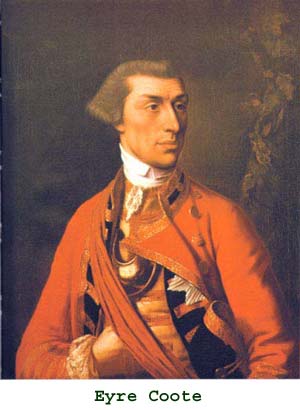- Eyre Coote (1726–1783)
Infobox Person
name = Eyre Coote

caption =
birth_date = 1726
birth_place =Limerick, Ireland
death_date = 1783
death_place =Madras
other_names =
known_for =
occupation =
relatives =
spouse =
website =
footnotes =Lieutenant-General Sir Eyre Coote, KB (1726 –April 28 ,1783 ), was an Irish soldier.The son of the Reverend Chidley Coote , he was born near
Limerick, Ireland in 1726, and entered the27th Regiment of Foot . He first saw active service in theJacobite rising of 1745, and later obtained a captaincy in the 39th Regiment, the first British regiment sent to India. In 1756 a part of the regiment, then quartered atMadras (now known asChennai ), was sent forward to joinRobert Clive in his operations againstCalcutta , which was reoccupied without difficulty. Coote was soon given the local rank of major for his good conduct in the surprise of the Nawab’s camp. Soon afterwards came theBattle of Plassey , which would probably never have taken place but for Coote’s advice at the council of war; after the defeat of the Nawab he led a detachment in pursuit of the French for 400 miles under extraordinary difficulties. His conduct won him the rank of lieutenant-colonel and the command of the84th Regiment of Foot , newly raised for Indian service, but his exertions had seriously damaged his health. In October 1759 Coote’s regiment arrived to take part in the decisive struggle between French and English in the Carnatic. He took command of the forces at Madras, and in 1760 led them in the decisive victory of Wandiwash (January 22 ). After a time the remnants of Lally’s forces were shut up inPondicherry . For some reason Coote was not entrusted with the siege operations, but loyally supportedWilliam Monson , who brought the siege to a successful end onJanuary 15 ,1761 .Soon afterwards Coote was given the command of the
British East India Company ’s forces inBengal , and settled of a serious dispute between theNawab Mir Qasim and a powerful subordinate. In 1762 he returned to England, receiving a jewelled sword of honour from the Company and other rewards for his great services. In 1771 he was made a K.B. In 1779 he returned to India as lieutenant-general commanding in chief. Following the policy ofWarren Hastings , he nevertheless refused to take sides in the quarrels of the council, and made a firm stand in all matters affecting the forces.Hyder Ali ’s progress in southern India called him back into the field, but it was not untilJune 1 ,1781 , that the crushing and decisive defeat of Porto Novo struck the first heavy blow against Hyder. The battle was won by Coote against odds of five to one, and is regarded as one of the greatest feats of the British in India. It was followed up by another hard-fought battle at Pollilur (the scene of an earlier triumph of Hyder over a British force) onAugust 27 , in which the British won another success, and by the rout of the Mysore troops at Sholingarh a month later. His last service was the arduous campaign of 1782, which finally shattered a constitution already gravely impaired by hardship and exertions. Sir Eyre Coote died at Madras, and a monument was erected to him inWestminster Abbey as well as within West Park,Rockbourne ,Hampshire . His nephew wasSir Eyre Coote, GCB .References
Wikimedia Foundation. 2010.
